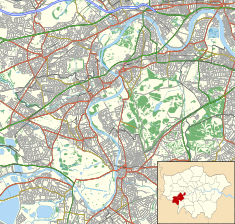| Great Pagoda | |
|---|---|
 "This supreme example of Chinoiserie" | |
| Type | Pagoda |
| Location | Kew Gardens, London |
| Coordinates | 51°28′17″N 0°17′45″W / 51.4713°N 0.2957°W |
| Height | 163 ft (50 m) |
| Built | 1761 |
| Restored | 2018 |
| Restored by | Austin-Smith:Lord |
| Current use | Museum |
| Architect | Sir William Chambers |
| Architectural style(s) | Chinoiserie |
| Governing body | Historic Royal Palaces |
Listed Building – Grade I | |
| Official name | The Pagoda |
| Designated | 10 January 1950 |
| Reference no. | 1262593[1] |
The Great Pagoda at Kew Gardens in southwest London was built in 1761 by Sir William Chambers as a present for Princess Augusta, the founder of the gardens. Constructed of grey brick, the pagoda comprises 10 storeys, totalling 163 ft (50 m) in height,[2] with 253 steps to the viewing gallery.[3] Closed for repairs in 2006, the pagoda was reopened in 2018 following a major programme of restoration. It is a Grade I listed building.[1]
The ground floor roof is supported on wooden pillars. The storeys above this have arcaded balconies with Chinese Chippendale railings and curved roofs.[1] The roofs are now of lead although they were originally covered in alternating bands of green and white tiles.[4] The 80 restored dragons surmount each roof.[a] Bridget Cherry, in her London 2: South volume of the Buildings of England series, describes the pagoda as "this supreme example of chinoiserie".[2] A study of 2019, written after the restoration, ranked it as "the most important surviving chinoiserie building in Europe".[5]
- ^ a b c d Cite error: The named reference
autowas invoked but never defined (see the help page). - ^ a b c Cherry & Pevsner 2002, p. 512.
- ^ "Climb the Great Pagoda at Kew". Royal Botanical Gardens Kew. Retrieved 16 May 2021.
- ^ Harris & Snodin 1996, p. 65.
- ^ Prosser, Lee (20 November 2019). "The Great Pagoda at Kew: Colour and Technical Innovation in Chinoiserie Architecture". Architectural History. 62. Cambridge University Press: 69–88. doi:10.1017/arh.2019.3. S2CID 214482397.
Cite error: There are <ref group=lower-alpha> tags or {{efn}} templates on this page, but the references will not show without a {{reflist|group=lower-alpha}} template or {{notelist}} template (see the help page).
